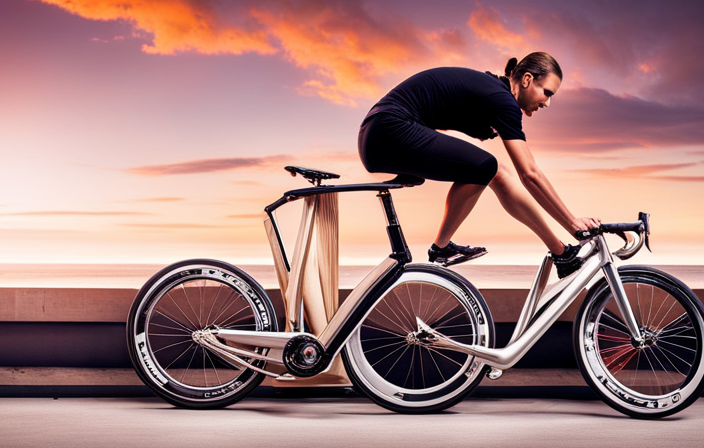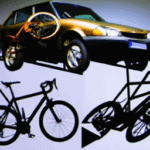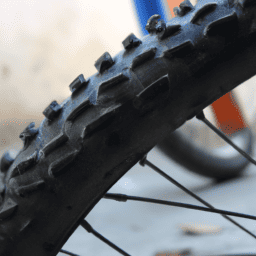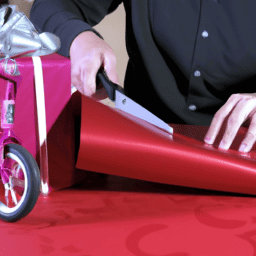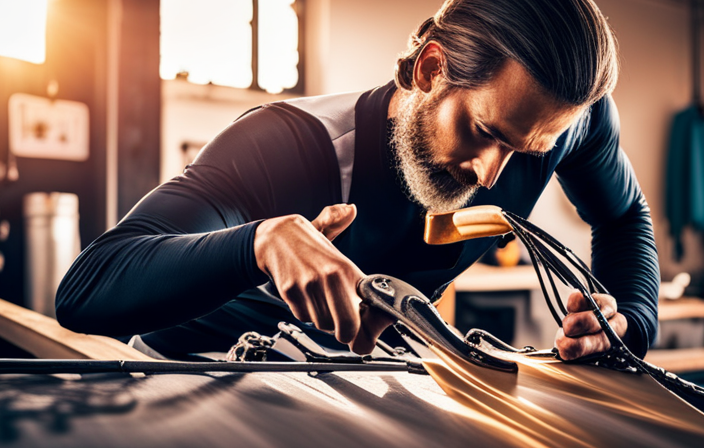Riding your bike with Uber Eats is like opening a new door of possibilities. It’s a refreshing experience, a pedal-powered adventure that lets you deliver tasty meals to hungry customers.
In this article, I will guide you through the process of adding a bicycle to your Uber Eats delivery arsenal. From meeting the requirements to maximizing your earnings, I’ll provide you with the detailed steps to get you on the road and enjoying the ride.
Let’s get started!
Key Takeaways
- Reliable bicycle in good working condition with functioning brakes and tires is required for deliveries.
- Sign up as a delivery partner and complete a background check before starting deliveries.
- Attend an onboarding session to learn more about the delivery process and maximize efficiency.
- Get the necessary gear such as the right bike, delivery bag, smartphone mount, and familiarize yourself with the app and its features for a smooth and efficient delivery experience.
Meet the Requirements
To add a bicycle to Uber Eats, you’ll need to meet the requirements.
First, you must make sure that you have a reliable bicycle that is suitable for making deliveries. It should be in good working condition with functioning brakes and tires.
Additionally, you will need to have a smartphone with the Uber Eats app installed. This will allow you to receive delivery requests and navigate to the customer’s location.
It’s important to note that each city may have specific requirements for bicycles, such as having a basket or bag for carrying food.
Once you have met these requirements and have a suitable bicycle, you can sign up as a delivery partner. This will give you access to the Uber Eats platform and allow you to start delivering food to customers.
Sign Up as a Delivery Partner
Get started by signing up as a delivery partner and enjoy the benefits of delivering using your bicycle on the Uber Eats platform.
As a delivery partner, you will have the opportunity to meet other drivers and be a part of a supportive community. This allows you to share experiences, tips, and even make new friends along the way.
Not only will you be contributing to the local economy, but you will also have the chance to earn extra income while enjoying the freedom of cycling around the city.
With flexible hours and the ability to choose when and where you want to work, becoming a delivery partner is a great way to fit work around your schedule.
Once you’ve signed up, the next step is to complete the background check and start delivering with Uber Eats.
Complete the Background Check
Once you’ve signed up as a delivery partner, you’ll need to complete the background check before you can start delivering.
The background check process is an important step in ensuring the safety of both Uber Eats customers and delivery partners. Uber Eats has specific background check requirements that need to be met in order to be approved for delivery.
These requirements may include a review of your criminal history, driving record, and other relevant records. The background check process typically takes a few days to complete, but it may take longer depending on your location and the volume of applications.
Once your background check is successfully completed and approved, you will be able to move on to the next step, which is attending an onboarding session to learn more about the delivery process and get started with delivering for Uber Eats.
Attend an Onboarding Session
After successfully completing the background check, you can attend an onboarding session to learn more about the delivery process and get started with delivering for Uber Eats. This session is designed to help you maximize efficiency and optimize your delivery routes. During the onboarding session, a representative will guide you through the app and provide tips on how to navigate the city effectively. They will also show you how to use the delivery bag and explain the importance of maintaining a high level of customer service. By attending this session, you will gain valuable insights that will help you become a successful Uber Eats delivery partner. Once you have completed the onboarding session, you will be ready to get the gear and start delivering delicious meals to hungry customers.
Get the Gear
To start delivering for Uber Eats, make sure you have the necessary equipment. Getting the gear is essential to ensure a smooth and efficient delivery experience.
One of the most important things is choosing the right bike. Consider the type of terrain you will be riding on and the distance you will be covering. A lightweight and sturdy bicycle is ideal for navigating through busy streets and delivering orders quickly.
Additionally, you will need a delivery bag or backpack to safely transport the food. It’s also important to have a smartphone mount or holder to keep your phone secure and easily accessible while riding.
Once you have all the necessary gear, you can move on to the next step of familiarizing yourself with the app and its features.
Familiarize Yourself with the App
Before you start delivering, make sure to familiarize yourself with the Uber Eats app and its features. The app is your key tool for successfully completing deliveries. Take the time to explore all the features and understand the navigation. This will help you become more efficient and deliver orders on time.
To get started, let me walk you through some of the main features of the app using a table:
| Feature | Description |
|---|---|
| Order Details | View important information about each order |
| Navigation | Get turn-by-turn directions to the customer’s location |
| Order Status | Track the progress of each delivery |
By familiarizing yourself with these features, you can ensure a smooth and seamless delivery process. Once you are comfortable with the app, you can plan your routes effectively and reach your customers in a timely manner. Now, let’s move on to the next section and discuss how to plan your routes efficiently.
Plan Your Routes
Now that I’m familiar with the Uber Eats app, I can move on to the next step in adding my bicycle to the platform.
It’s important to plan my routes efficiently to maximize my earnings and minimize my delivery times. Luckily, Uber Eats provides route optimization and navigation tools to help me do just that.
With these tools, I can easily find the most efficient routes to my delivery destinations, avoiding traffic and taking shortcuts when necessary. This not only saves me time, but also ensures that I can complete more deliveries in a shorter amount of time.
By optimizing my routes, I can increase my earning potential and provide faster service to customers.
Now, let’s move on to the next section and learn how to stay safe on the road while making deliveries.
Stay Safe on the Road
When it comes to staying safe on the road, I always keep three key points in mind.
First, it’s important to obey traffic laws at all times. This means stopping at red lights, yielding to pedestrians, and following the rules of the road.
Second, using hand signals is crucial for communicating with other drivers and cyclists. Whether I’m turning left, right, or stopping, I always make sure to signal my intentions clearly.
Lastly, being aware of my surroundings is essential. I constantly scan the road for potential hazards, such as potholes or parked cars opening their doors, and adjust my route accordingly.
By following these three points, I can ensure a safe and enjoyable ride every time.
Obey Traffic Laws
To safely deliver food as a cyclist for Uber Eats, it’s important to obey traffic laws. By following these laws, not only am I ensuring road safety, but I am also setting a good example for other cyclists and drivers. Here are four key traffic laws that I always keep in mind:
- Stop at red lights and stop signs, even if there are no cars around.
- Yield to pedestrians at crosswalks and always give them the right of way.
- Ride in the same direction as traffic, staying as far to the right as possible.
- Use bike lanes when available, and if not, ride in the center of the lane to increase visibility.
By obeying these traffic laws, I can ensure a smooth and safe delivery experience for both myself and others on the road.
Speaking of safety, another important aspect is using hand signals to communicate my intentions to other road users.
Use Hand Signals
Using hand signals is essential for communicating my intentions to other road users while delivering food as a cyclist for Uber Eats. By using these signals, I can ensure road safety and avoid any potential accidents. The use of signals allows me to alert drivers, pedestrians, and other cyclists of my intentions, such as turning or stopping. This helps to prevent any confusion or miscommunication on the road, making the delivery process smoother and safer for everyone involved.
To illustrate the importance of hand signals, I have created a table below that outlines the different signals and their meanings:
| Hand Signal | Meaning |
|---|---|
| Left hand extended straight out | I am turning left |
| Left arm bent at a 90-degree angle upward | I am turning right |
| Left arm bent at a 90-degree angle downward | I am stopping |
By consistently using these signals, I can ensure that other road users are aware of my movements and can adjust their actions accordingly. This promotes a safer environment for all on the road.
In the next section about being aware of my surroundings, I will discuss further ways I ensure road safety while delivering for Uber Eats.
Be Aware of Surroundings
Stay aware of your surroundings at all times while delivering food as a cyclist for Uber Eats. It is crucial to undergo awareness training to develop situational awareness skills.
Firstly, imagine riding through a busy city street during rush hour. Cars whizzing by, pedestrians crossing the road, and delivery instructions popping up on your phone.
Secondly, picture navigating through narrow alleyways with low-hanging branches and uneven surfaces. Be cautious of potential hazards like potholes or unexpected obstacles.
Finally, envision delivering food to a customer’s doorstep in a dimly lit neighborhood. Stay vigilant and trust your instincts to ensure your safety and the timely delivery of meals.
By staying alert and aware, you can navigate through any situation and provide excellent service to your customers.
Transitioning into the next section, effective communication is key when interacting with customers.
Communicate with Customers
Make sure you’re always available to respond to customer inquiries and address any concerns promptly. Customer feedback is crucial for improving your service and building a positive reputation. When handling complaints, it’s important to remain calm and empathetic, as this can turn a dissatisfied customer into a loyal one. Actively listen to their concerns and take immediate action to resolve the issue. To help you visualize the impact of effective communication, consider the following table:
| Customer Concerns | My Response | Result |
|---|---|---|
| Late delivery | Apologize and offer a discount on next order | Customer satisfaction and loyalty |
| Incorrect order | Apologize and arrange for a replacement | Customer trust and positive reviews |
| Missing items | Apologize and provide a refund | Customer trust and repeat business |
| Rude behavior | Apologize and address the issue with the delivery partner | Customer reassurance and improved service |
By effectively communicating with customers, you can ensure their satisfaction and build a strong relationship. Moving forward, let’s discuss how to manage your schedule efficiently without compromising on customer service.
Manage Your Schedule
When it comes to managing my schedule as a delivery driver, there are three key points that I focus on.
First, I make sure to set my availability and delivery zones in advance, so that I can maximize my efficiency and minimize unnecessary travel time.
Next, I always plan for peak delivery times, such as lunch and dinner rushes, to ensure that I am able to fulfill orders in a timely manner.
Lastly, I understand the importance of being flexible and adjusting my schedule as needed, whether it’s accommodating for unexpected traffic or taking advantage of high-demand periods.
Set Availability and Delivery Zones
To add a bicycle to Uber Eats, you can simply set your availability and delivery zones.
By accessing the Uber Eats app, you can easily navigate to the ‘Manage Schedule’ section and choose the hours you wish to work.
Additionally, you can set your delivery zones by adjusting the radius in which you are willing to deliver. This allows you to expand your delivery radius and reach more customers.
In order to maximize your earnings, it is important to set competitive delivery fees that align with the market.
Once you have set your availability and delivery zones, you can then plan for peak delivery times to further optimize your earnings.
By analyzing historical data and understanding customer demand patterns, you can strategically plan your shifts to ensure maximum efficiency and profitability.
Plan for Peak Delivery Times
During peak delivery times, I strategize my shifts to ensure maximum efficiency and profitability. Peak delivery strategies are essential for managing delivery time constraints. To effectively plan for peak times, I use a combination of the following strategies:
-
Optimize delivery routes: I plan my routes to minimize travel time and maximize the number of deliveries I can complete in a given time frame.
-
Prioritize high-demand areas: I focus on areas with high customer demand to increase my chances of receiving more orders and earning higher tips.
-
Utilize real-time data: I stay updated on real-time data to identify busy periods and adjust my schedule accordingly.
-
Coordinate with restaurants: I communicate with restaurants to streamline the pickup process and reduce waiting time.
By implementing these strategies, I can efficiently manage peak delivery times and maximize my earnings. However, it is important to remain flexible and adjust my schedule as needed to adapt to changing demand and traffic conditions.
Adjust Your Schedule as Needed
After creating a plan for peak delivery times, the next step is to adjust your schedule as needed.
As a bicycle courier for Uber Eats, I understand the importance of maintaining a healthy work-life balance. By adjusting my schedule, I can ensure that I have enough time for personal activities and rest, while also maximizing my earnings during busy delivery periods.
This means being flexible and adapting to changes in demand. For example, if there is a sudden surge in orders during lunchtime, I can choose to extend my shift or take a break earlier in the day to accommodate the increased workload.
By finding the right balance between work and personal life, I can avoid burnout and enjoy the benefits of being an Uber Eats bicycle courier.
Now, let’s move on to the next step: tracking your earnings.
Track Your Earnings
You can easily track your earnings as a bicycle delivery partner on Uber Eats. The earnings tracking feature provides a detailed breakdown of your income, allowing you to monitor your performance and evaluate your progress.
It shows you the total amount earned for each delivery, as well as any tips received. Additionally, you can view your earnings on a daily, weekly, or monthly basis, giving you a clear picture of your financial performance over time.
This feature is incredibly helpful in helping you set goals, track your progress, and make adjustments to your delivery strategy as needed. By staying on top of your earnings, you can ensure that you are maximizing your potential and making the most out of your time on the road.
As a result, you’ll be better equipped to handle difficult situations that may arise during your deliveries.
Handle Difficult Situations
When faced with difficult situations, it’s important to remain calm and handle them with professionalism and assertiveness. Dealing with difficult customers can be challenging, but it’s crucial to listen to their concerns and address them in a respectful manner.
Sometimes accidents happen, and it’s essential to handle them swiftly and efficiently. If you’re involved in an accident while delivering on your bicycle, make sure to prioritize your safety and the safety of others involved. Contact the necessary authorities and report the incident immediately. Additionally, remember to document any details or evidence that may be helpful later on. By handling difficult situations with composure and taking the necessary steps, you can ensure the best outcome for everyone involved.
Transitioning into the next section about staying healthy and hydrated, it’s vital to prioritize your well-being while on the road.
Stay Healthy and Hydrated
When delivering for Uber Eats, it’s crucial to stay hydrated throughout your shifts.
It’s important to take breaks and stretch to avoid muscle strain and fatigue.
Additionally, practicing proper ergonomics will help prevent any long-term health issues.
Stay Hydrated During Deliveries
To stay hydrated during deliveries, make sure you’re drinking enough water throughout the day. Water intake is crucial for staying cool and preventing heat exhaustion, especially when you’re out on the road for long periods.
As a delivery cyclist, it’s important to have delivery essentials and gear that ensures your safety and road safety.
Additionally, customer communication is key for building relationships and providing excellent service. Time management and scheduling tips can help you make the most of peak hours, maximizing your earnings while still taking care of your health.
Incorporate self-care into your routine by exercising during deliveries to maintain energy levels and enjoy the job. Remember, taking breaks and stretching are also essential for staying healthy and avoiding fatigue.
Transitioning to the next section, it’s important to prioritize breaks and stretching to keep your body in top shape.
Take Breaks and Stretch
When you’re out on the road delivering orders, it’s important to take care of yourself to ensure a smooth and successful experience. One essential aspect of this is staying hydrated, as I mentioned in the previous section. Another crucial element is taking breaks and stretching. It’s easy to get caught up in the hustle and forget to give your body a break, but this can lead to fatigue and potential injuries. By incorporating regular breaks into your delivery routine, you give yourself a chance to rest and recharge. During these breaks, take the time to stretch your muscles and alleviate any tension. This will not only help prevent injuries but also improve your overall comfort and stamina. By taking care of yourself in these ways, you’ll be able to deliver efficiently and effectively. And remember, proper ergonomics is key, as I’ll discuss in the next section.
Practice Proper Ergonomics
Make sure you practice proper ergonomics while delivering orders to avoid strain and discomfort. Practicing efficiency is essential to maximize your earnings and prevent injuries.
When riding your bicycle, find a comfortable riding position that allows you to maintain a relaxed posture. Adjust your seat height so that your knees are slightly bent when pedaling. Keep your back straight and your shoulders relaxed to avoid putting unnecessary strain on your neck and back.
Additionally, make sure your bike is properly fitted and maintained to ensure smooth and efficient rides. Use your body weight to shift gears and avoid excessive strain on your legs.
By practicing proper ergonomics, you can deliver orders more efficiently and comfortably, ultimately maximizing your earnings.
Transitioning into the next section, let’s explore how you can further maximize your earnings with some smart strategies.
Maximize Your Earnings
Boost your earnings by maximizing the number of deliveries you can make as a bicycle delivery partner for Uber Eats.
To maximize efficiency, it’s important to improve navigation. Familiarize yourself with the delivery area, identify shortcuts, and use a reliable navigation app to find the quickest routes.
Optimize your delivery strategy by grouping orders that are near each other, saving time and energy. Additionally, keep an eye on surge pricing to prioritize deliveries in high-demand areas.
Remember to communicate with customers to ensure smooth deliveries and minimize any potential delays.
By implementing these strategies, you can increase your earnings by completing more deliveries in less time.
So, buckle up and enjoy the ride while boosting your income.
Enjoy the Ride
Take in the scenery and savor the freedom of being a bicycle delivery partner for Uber Eats while enjoying the ride. As a cyclist, you have the advantage of exploring enjoyable routes that are often inaccessible to cars. You can pedal through parks, bike lanes, and quiet neighborhoods, making each delivery an opportunity to discover new sights and sounds.
To ensure a smooth and enjoyable ride, regular bike maintenance is crucial. Keep your tires properly inflated, brakes in good condition, and chain well lubricated. It’s also important to check for any loose bolts or parts that may need tightening.
By taking care of your bike and choosing scenic routes, you can make each delivery a pleasant experience for both yourself and the customers you serve.
Frequently Asked Questions
How much does it cost to add a bicycle to Uber Eats?
Adding a bicycle to Uber Eats is a cost-effective option for delivery. The cost of bicycle delivery varies depending on location, but it offers numerous benefits such as avoiding traffic, reducing emissions, and providing a more efficient way to deliver food.
Can I use a motorized bicycle for Uber Eats deliveries?
Using a motorized bicycle for Uber Eats deliveries is a popular alternative. It’s efficient and eco-friendly, allowing me to navigate traffic easily. Plus, it saves me money on gas and reduces my carbon footprint.
Is there a minimum age requirement to deliver with a bicycle on Uber Eats?
To deliver with a bicycle on Uber Eats, you must meet the minimum age requirement and pass the necessary background checks. Uber Eats ensures the safety of its customers and delivery partners through these measures.
Are there any specific requirements for the type of bicycle I can use?
There are specific requirements for the type of bicycle I can use for Uber Eats. It must be a non-motorized bicycle, and there is no age requirement. Additionally, I can use a bike trailer for larger orders. The cost is minimal.
Can I deliver on Uber Eats with a bike trailer for larger orders?
Yes, you can deliver on Uber Eats with a bike trailer for larger orders. However, there may be bicycle trailer limitations, so it’s important to check with Uber Eats for specific guidelines. If the trailer is not allowed, explore alternative delivery options.
Conclusion
In conclusion, becoming a bicycle delivery partner for Uber Eats is a thrilling and rewarding experience. By following the steps outlined above, you can easily join the team and start delivering food with your bike.
Remember, success comes to those who are well-prepared and determined. So gear up, stay hydrated, and enjoy the ride! Just like riding a bike, life is all about balancing and moving forward.
So pedal on, and let the winds of opportunity lead you to greater heights.

